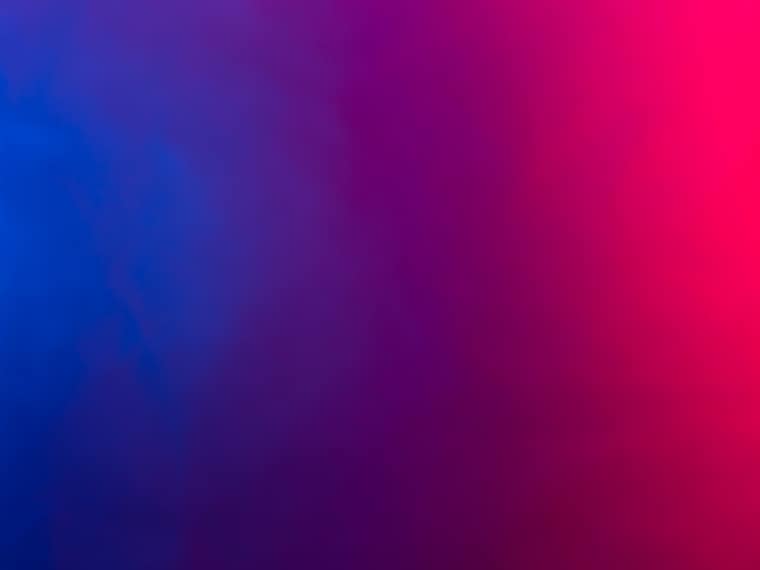Are you wondering what color red and blue make when mixed? In today’s article, you’ll learn all about this mix with both paint pigments and light, as well as what you should keep in mind when mixing these colors.
There are a lot of colors that come in the standard paint sets. However, some of them you have to make yourself. One of them even answers the question, “What color do red and blue make when combined?”
If you’ve come this far, you want to know what color results when you mix red and blue.
The combination of red and blue is quite popular, especially when you match darker shades of blue, like Cobalt or Navy, with brighter reds. This way, you get a great classic look.
But what color emotions do you get when you mix red and blue?
Mixing red and blue brings a royal touch, combining red’s energy with blue’s serenity.
Let’s find out more about this blend.
How Can You Mix Red and Blue?
In today’s article, we will try to answer several questions about mixing red and blue. We will tackle all the aspects individually to achieve the perfect mix. First, let’s discuss how you can mix these two colors.
Although it appears straightforward at first glance, there are a few considerations. Especially if you want to do this mix correctly.
First, you need to consider the medium in which you want to do the mix.
If we’re talking about color mixing, you’re definitely considering paint. This is the medium of choice for many of us. Even pastels are a great medium for color mixing. However, it is a more difficult choice for the inexperienced.
In terms of paint mixing, although you can predict the result in many cases, it may differ from the color you expect to achieve. That’s why the best lesson is the experience. And that comes with trial and error.
The easiest way is to play on cardboard or even a piece of wood. That way, you can try different shades of the colors you mix. But, of course, you’ll see that the shades you get differ depending on the types of paint you use.
Depending on what you are painting, you will use a different way of mixing colors. For example, a frozen lake will have different tones than a clear sky.
However, there are plenty of tools to get a perfect mix.
Now you know how to mix blue and red properly. Right? Let’s see what colors you can get from this mixture.
What Color Do Red and Blue Make With Paint Pigments?
When blue and red colors are mixed, the color produced is purple. Purple is a secondary color created by mixing an equal ratio of two primary colors (blue and red).
Purple is generally a cool color that has many shades, such as violet, lavender, lilac, mauve, or amethyst.
Furthermore, purple is situated between blue and red on the color wheel.
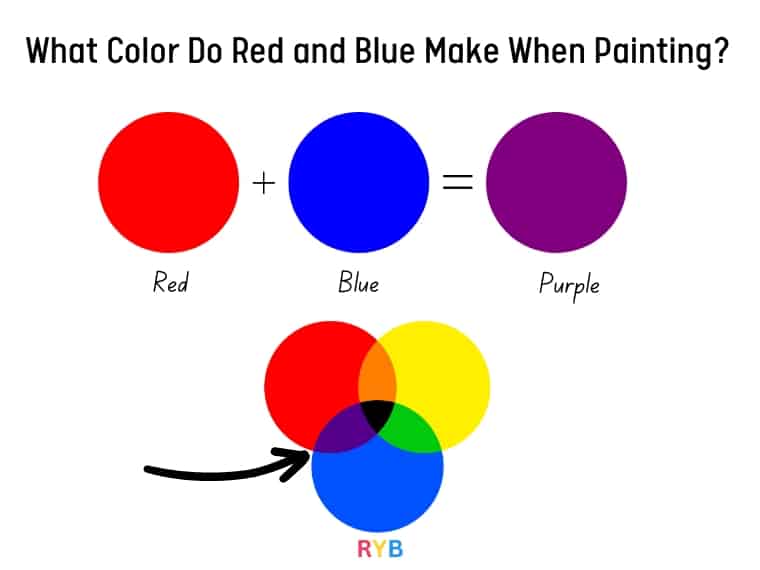
Why Do Red and Blue Make Purple?
When you mix red and blue pigments or dyes together, you’ll get purple.
This happens because of the way the pigments absorb and reflect different wavelengths of light.
This process is also called subtractive color mixing and refers to how dyes and pigments are made.
Red paint absorbs green light and reflects red and blue wavelengths. On the other hand, blue paint absorbs orange and yellow light and reflects blue and some red light.
When you mix two pigments or dyes, the colorants in each pigment or dye will interact. For example, the colorant in one pigment will absorb some of the wavelengths of light that the colorant in the other pigment reflects.
Therefore, depending on the types of blue and red, you can get a different shade of purple.
When mixing red and blue pigments, red will absorb some of the blue wavelengths of light that the blue colorant reflects, and blue will absorb some of the red wavelengths of light that red reflects.
This results in a mixture that reflects a reduced amount of red and blue light and therefore appears purple to your eyes.
Are Red and Blue a Good Combination to Mix?
The colors come in cool and warm tones, and the red and blue combination includes both.
Red is a warm color associated with passion, strength, and action.
Blue is generally a cool color, conveying feelings of tranquility, relaxation, trust, and loyalty.
So red and blue are a great combination to mix together.
While blue reminds us of cold, water, and mist, red makes us think of the power of the sun and warm weather.
However, color temperature is relative. Thus, each of them can have a color bias. For example, you can use a warm yellowish red or a cool bluish red. Similarly, you can mix a cool greenish blue or a warm reddish blue.
But how are they located on the color wheel?
When it comes to traditional art (the RYB color model), red, yellow, and blue are primary colors.
By mixing the primary colors (red, yellow, and blue), you get the secondary colors (purple, orange, and green). These are situated between the primary colors on the color wheel.
Mixing the primary colors with the adjacent secondary colors produces the intermediate colors.
Can You Mix Red and Blue From Scratch?
Both red and blue are primary colors in the RYB color space. So, it is said that primary colors cannot be created by mixing other colors.
However, the CMYK subtractive model shows that red can be created by mixing cyan and magenta. On the other hand, blue can be produced by blending magenta and yellow.
So by mixing the primary colors of the CMYK color model (cyan, magenta, and yellow), you get the primary additive colors of the RGB color model (red, green, and blue).
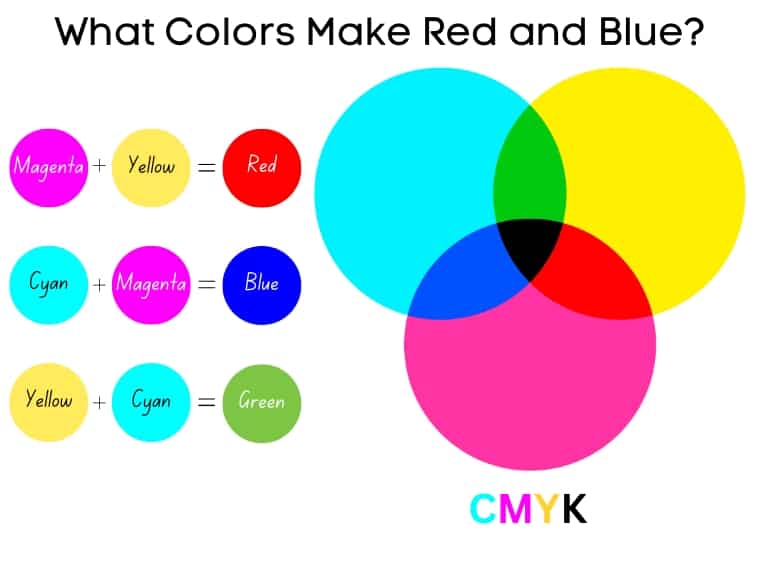
Why Mixing Blue and Red Does Not Always Make Purple
Manufacturers make their paints in a different way. Thus, many types of blue and red paint are on the market. Unfortunately, while some mixes produce a perfect purple, others can fail and produce muddy or dull purples.
For example, some variations of blue or red contain very little yellow. Combining all the primary colors will produce brown. But not just any brown, but rather a muddy brown.
That’s why it’s important to make sure you buy colors that are as pure as possible. Even a small amount of yellow in the composition of one of the two colors will affect the mixture.
Another critical factor is the medium you are using. For example, you can get different shades of purple using acrylic paints, oil paints, or watercolors.
A perfect purple can be produced by mixing Alizarin crimson with Ultramarine blue. This is due to Alizarin’s blue undertones, which make it a cool red.
If you want to get violet, mix Permanent rose with Cerulean Blue paint.
Purple is a Combination of Red and Blue
As an artist or designer, knowing as much as possible about the colors you’re mixing is beneficial.
Purple is a color associated with royalty, luxury, creativity, and wisdom. It is an uplifting color that illuminates, being closely linked to spirituality.
Furthermore, purple is the color of mystery and magic, combining the energy of red with the serenity of blue.
Purple is also said to uplift, inspire and encourage you to be yourself. But on the other hand, it is associated with immaturity and hypersensitivity. It is also said to symbolize pride and extravagance.
Read more about the purple color meaning.
Purple vs. Violet
Purple
Hex: #800080
RGB: 128, 0, 128
CMYK: 0, 100, 0, 50
Violet
Hex: #8F00FF
RGB: 143, 0, 255
CMYK: 44, 100, 0, 0
Purple and violet are used interchangeably, but only a few know they are two different colors. However, there are some differences between purple and violet.
Purple is a non-spectral color, while violet appears on the color spectrum. In addition, purple is an equal mix of blue and red, while violet contains more blue.
Violet has the shortest wavelength and is located at the lowest end of the light spectrum. On the other hand, purple does not appear on the color spectrum, being a range of colors between blue and red.
To make violet, mix Ultramarine blue with Quinacridone magenta using a 1:2 ratio. If you want to lighten up the resulting color, add a little Titanium white.
If you want to make a deep purple, mix Cerulean blue or Ultramarine blue with Alizarin Crimson.
Purple vs. Indigo
Purple
Hex: #800080
RGB: 128, 0, 128
CMYK: 0, 100, 0, 50
Indigo
Hex: #4B0082
RGB: 75, 0, 130
CMYK: 42, 100, 0, 49
Indigo is a shade of purple that contains more blue than red, as opposed to purple, which is an equal mix of the two colors. Furthermore, indigo is a dark purple color that appears on the spectrum, unlike purple.
If you mix indigo paint, use a light blue as a base and add a little red paint until you reach the desired indigo color.
Indigo is used in painting to draw nightscapes.
Mixing Different Shades of Purple Paint
You can mix different shades of purple with paint, just like in the digital environment. But to know how to lighten or darken a color, it’s important to know what shades, tints, and tones are.
Shades of Color
Shades are darker variations of a base hue created by adding black. To darken a color, add a little black paint. But you must be careful because black paint can quickly alter your color.
So to make purple darker, add a little black paint. Alternatively, you can add a darker blue, such as Navy blue or Phthalo blue.
Tints of Color
Tints are lighter variations of a base hue, as opposed to shades. They are created by adding white paint. So, to lighten the purple, add a little white paint. Alternatively, you can add a little yellow, its complementary color.
Tones of Color
Tones are created by mixing gray with a base hue. Also, tones depend on the amount of black and white in the gray. These are more subtle variations, just like tints.
If shades are darker variations that can go almost black, tints are lighter variations that tend towards pastels. Conversely, tints are more subtle variations that become closer to the gray used as you add more gray.
What Color Do Red and Blue Make With Light?
When red and blue lights are mixed, the color produced is magenta. Magenta is a secondary color in the RGB color model, which is obtained by mixing two primary colors (red and blue).
Furthermore, because it is located between red and purple on the color wheel, magenta is also known as purplish-red or reddish-purple.
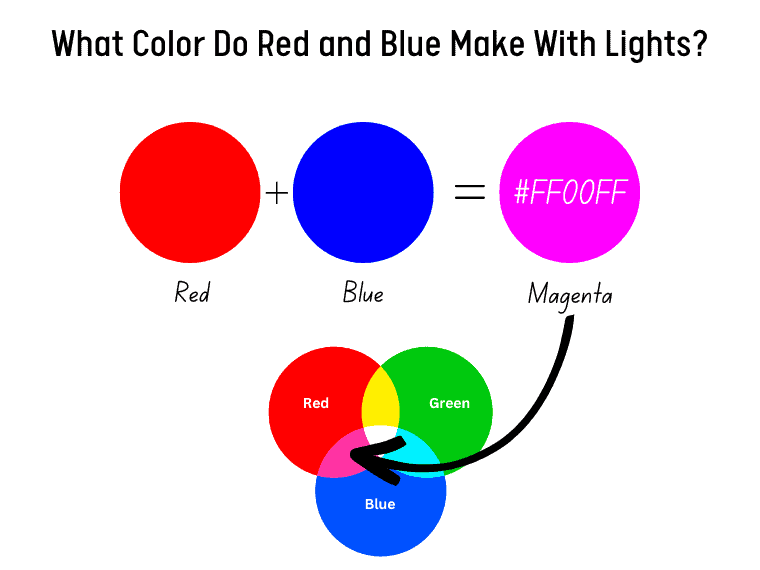
So, when it comes to light, things are different.
Unlike traditional art, light uses other primary colors, namely red, green, and blue.
Red, green, and blue is the abbreviation of the RGB color model, which deals with light and everything related to digital. So all colors result from mixing these three primary colors at different light intensities.
The secondary colors of the RGB space are cyan, magenta, and yellow. They are the result of mixing the primary colors. For example, magenta is produced by mixing red and blue light.
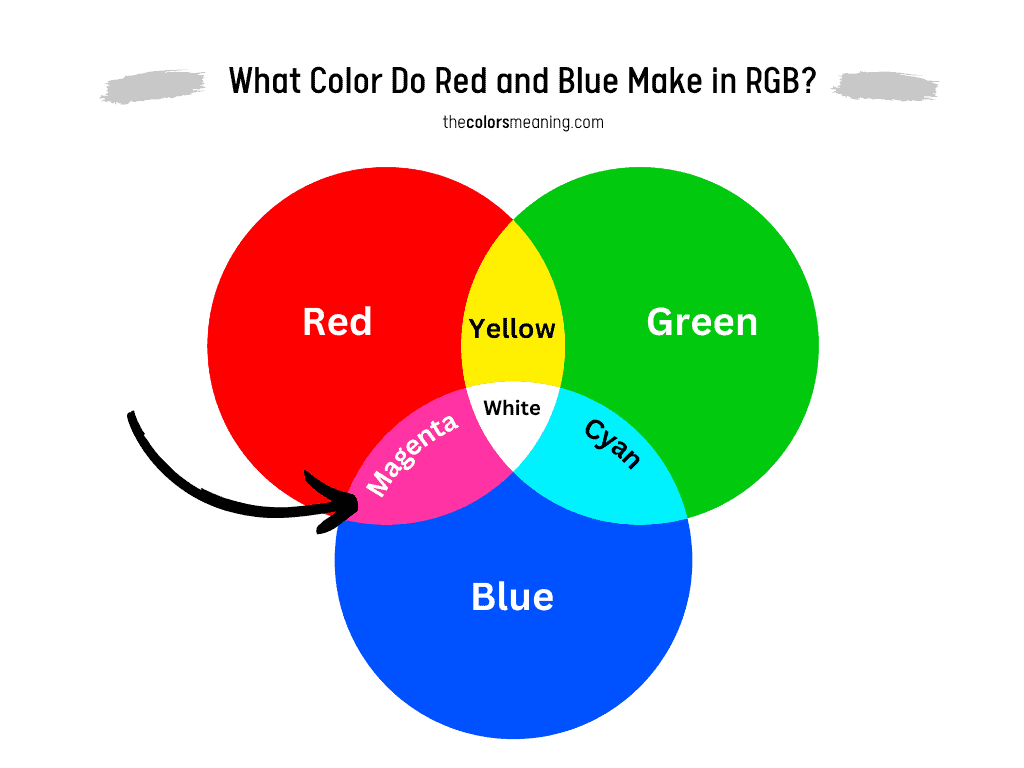
While RYB and CMYK are subtractive models, RGB color space is additive. This means that when you mix the colors of the visible spectrum in RGB, you get white light. Interestingly, this additive model starts with black (dark) and gets brighter as color is added.
However, it is interesting that in both light and paint, the mix of these two colors produces a secondary color.
But what exactly is visible light?
Understanding the Spectrum of Light
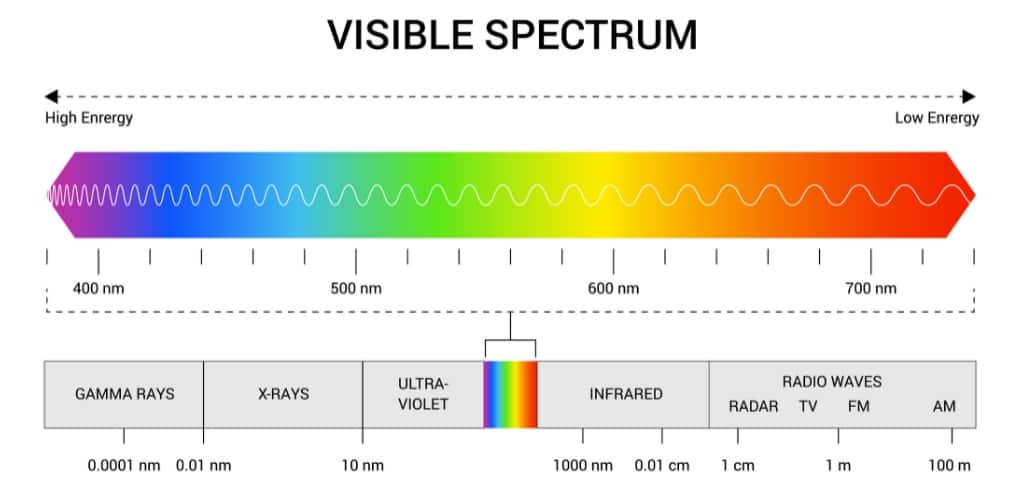
Light is actually energy. Thus, it is about electromagnetic radiation.
In the electromagnetic spectrum, known as the electromagnetic radiation spectrum, different frequencies are assigned to radio, microwave, infrared, visible light, ultraviolet, X-ray, and Gamma-ray. Each of these has a wavelength range. [1]
The human eye can see the spectrum between infrared and ultraviolet radiation, known as the “visible spectrum.” This is where the visible light comes in.
The visible spectrum is the range of the electromagnetic spectrum that the human eye can see. It ranges between 380 and 700 nanometers. Thus, this range is called visible light.
Last Words on What Color Do Blue and Red Make when Mixed
So, what color does red and blue make when mixed?
If you mix red and blue in the paint, you get purple. On the other hand, combining red and blue in light will produce magenta. So, depending on the medium, mixing red and blue will result in two colors.
Whether you mix red and blue in RYB space or in the RGB model, the result is a secondary color: purple in paint or magenta in light.
Did you enjoy the article about what color is created by mixing red and blue? Please help us spread the word by sharing this article with your friends who might be interested.

